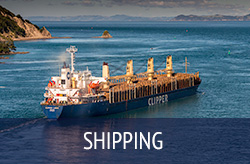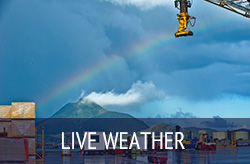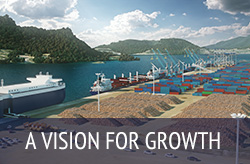Some dairy exports start leaving Northland by sea instead of road
Some of Northland’s dairy exports are now heading overseas through the region’s own port in a trial involving Fonterra and Kotahi, New Zealand’s largest containerised freight manager.
Containers full of dairy products are now being shipped between Northport and Port of Tauranga on Pacifica Shipping’s weekly container service linking the two ports. The initial trial will use a mix of carriers and see around 100 containers taken off the road. If successful, the arrangement could see up to 800 containers off the road annually, with potential for future growth.
Northport’s commercial manager David Finchett said the port had been in discussion with the two organisations “for some time” around the efficiencies offered by coastal shipping for Northland dairy products exported through Tauranga. Recent road transport disruptions and the introduction in May of Pacifica’s weekly coastal shipping service had triggered the decision to shift from road to sea.
At the time of the launch of Pacifica Shipping’s weekly container service Mr Finchett said it would ensure much more frequent, efficient connections between Northland and the world, and give shippers more options to reduce their carbon footprint and improve supply chain resilience and efficiency.
David Ross, chief executive of Kotahi said the coastal shipping trial from Northport to Port of Tauranga would help build stability in New Zealand’s supply chain, offering an efficient alternative to road and rail transport to ensure cargo can get to export markets reliably.
“We have faced disruptions in landside movements over the last few years,” Mr Ross said. “The option of coastal shipping creates more resilience in our export supply chain.”
The New Zealand Shipping Federation says that coastal shipping produces significantly lower emissions per tonne of freight than other modes of freight transportation.
European Union figures show that coastal shipping produces around 12.5 percent of the emissions per tonne of freight moved by road and around 60 percent of the emissions per tonne of freight moved by rail. A more recent University of Canterbury study, which includes port-side emissions, indicates that in the New Zealand context coastal shipping produces around 20 percent of the emissions per tonne of freight moved by road, and just under half the emissions of rail.
The Ministry of Transport forecasts that total freight volumes will increase by at least 50 percent by 2040. This builds on a 50 percent increase in freight volumes moved by coastal shipping over the past 10 years.
“We’re pleased to help Northland exporters drive this change,” Mr Finchett said. “They can have their containers loaded at Northport and just over 12 hours later the ship will be in Tauranga, from where there are regular connections available to almost anywhere.”
The weekly service has also improved freight transit times for Northland importers, bypassing State Highway 1 roadworks and detours, Auckland traffic and the Cook Strait.
- ends –










